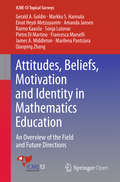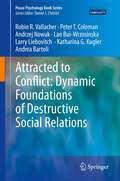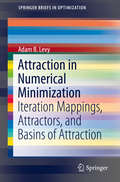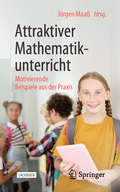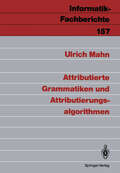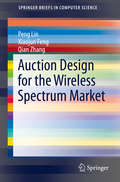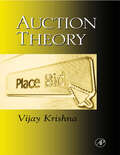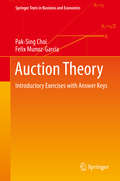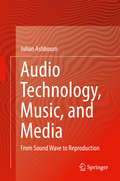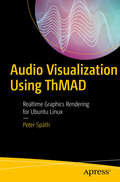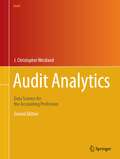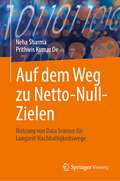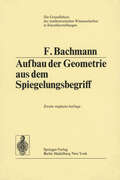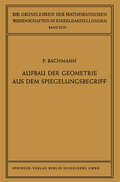- Table View
- List View
Attitudes, Beliefs, Motivation and Identity in Mathematics Education: An Overview of the Field and Future Directions (ICME-13 Topical Surveys)
by Markku S. Hannula Pietro Di Martino Marilena Pantziara Qiaoping Zhang Francesca Morselli Einat Heyd-Metzuyanim Sonja Lutovac Raimo Kaasila James A. Middleton Amanda Jansen Gerald A GoldinThis book records the state of the art in research on mathematics-related affect. It discusses the concepts and theories of mathematics-related affect along the lines of three dimensions. The first dimension identifies three broad categories of affect: motivation, emotions, and beliefs. The book contains one chapter on motivation, including discussions on how emotions and beliefs relate to motivation. There are two chapters that focus on beliefs and a chapter on attitude which cross-cuts through all these categories. The second dimension covers a rapidly fluctuating state to a more stable trait. All chapters in the book focus on trait-type affect and the chapter on motivation discusses both these dimensions. The third dimension regards the three main levels of theorizing: physiological (embodied), psychological (individual) and social. All chapters reflect that mathematics-related affect has mainly been studied using psychological theories.
Attracted to Conflict: Dynamic Foundations of Destructive Social Relations (Peace Psychology Book Series)
by Robin R. Vallacher Peter T. Coleman Andrzej Nowak Lan Bui-Wrzosinska Larry Liebovitch Katharina Kugler Andrea BartoliConflict is inherent in virtually every aspect of human relations, from sport to parliamentary democracy, from fashion in the arts to paradigmatic challenges in the sciences, and from economic activity to intimate relationships. Yet, it can become among the most serious social problems humans face when it loses its constructive features and becomes protracted over time with no obvious means of resolution. This book addresses the subject of intractable social conflict from a new vantage point. Here, these types of conflict represent self-organizing phenomena, emerging quite naturally from the ongoing dynamics in human interaction at any scale—from the interpersonal to the international. Using the universal language and computational framework of nonlinear dynamical systems theory in combination with recent insights from social psychology, intractable conflict is understood as a system locked in special attractor states that constrain the thoughts and actions of the parties to the conflict. The emergence and maintenance of attractors for conflict can be described by means of formal models that incorporate the results of computer simulations, experiments, field research, and archival analyses. Multi-disciplinary research reflecting these approaches provides encouraging support for the dynamical systems perspective. Importantly, this text presents new views on conflict resolution. In contrast to traditional approaches that tend to focus on basic, short-lived cause-effect relations, the dynamical perspective emphasizes the temporal patterns and potential for emergence in destructive relations. Attractor deconstruction entails restoring complexity to a conflict scenario by isolating elements or changing the feedback loops among them. The creation of a latent attractor trades on the tendency toward multi-stability in dynamical systems and entails the consolidation of incongruent (positive) elements into a coherent structure. In the bifurcation scenario, factors are identified that can change the number and types of attractors in a conflict scenario. The implementation of these strategies may hold the key to unlocking intractable conflict, creating the potential for constructive social relations.
Attraction in Numerical Minimization: Iteration Mappings, Attractors, and Basins of Attraction (SpringerBriefs in Optimization)
by Adam B. LevyNumerical minimization of an objective function is analyzed in this book to understand solution algorithms for optimization problems. Multiset-mappings are introduced to engineer numerical minimization as a repeated application of an iteration mapping. Ideas from numerical variational analysis are extended to define and explore notions of continuity and differentiability of multiset-mappings, and prove a fixed-point theorem for iteration mappings. Concepts from dynamical systems are utilized to develop notions of basin size and basin entropy. Simulations to estimate basins of attraction, to measure and classify basin size, and to compute basin are included to shed new light on convergence behavior in numerical minimization. Graduate students, researchers, and practitioners in optimization and mathematics who work theoretically to develop solution algorithms will find this book a useful resource.
Attractivity and Bifurcation for Nonautonomous Dynamical Systems (Lecture Notes in Mathematics #1907)
by Martin RasmussenAlthough, bifurcation theory of equations with autonomous and periodic time dependence is a major object of research in the study of dynamical systems since decades, the notion of a nonautonomous bifurcation is not yet established. In this book, two different approaches are developed which are based on special definitions of local attractivity and repulsivity. It is shown that these notions lead to nonautonomous Morse decompositions.
Attractors, Bifurcations, and Chaos: Nonlinear Phenomena in Economics
by Tönu PuuAttractors, Bifurcations, & Chaos - now in its second edition - begins with an introduction to mathematical methods in modern nonlinear dynamics and deals with differential equations. Phenomena such as bifurcations and deterministic chaos are given considerable emphasis, both in the methodological part, and in the second part, containing various applications in economics and in regional science. Coexistence of attractors and the multiplicity of development paths in nonlinear systems are central topics. The applications focus on issues such as business cycles, oligopoly, interregional trade dynamics, and economic development theory.
Attractors, Bifurcations, & Chaos: Nonlinear Phenomena in Economics
by Tönu PuuAttractors, Bifurcations, & Chaos - now in its second edition - begins with an introduction to mathematical methods in modern nonlinear dynamics and deals with differential equations. Phenomena such as bifurcations and deterministic chaos are given considerable emphasis, both in the methodological part, and in the second part, containing various applications in economics and in regional science. Coexistence of attractors and the multiplicity of development paths in nonlinear systems are central topics. The applications focus on issues such as business cycles, oligopoly, interregional trade dynamics, and economic development theory.
Attractors for infinite-dimensional non-autonomous dynamical systems (Applied Mathematical Sciences #182)
by Alexandre Carvalho José A. Langa James RobinsonThe book treats the theory of attractors for non-autonomous dynamical systems. The aim of the book is to give a coherent account of the current state of the theory, using the framework of processes to impose the minimum of restrictions on the nature of the non-autonomous dependence. The book is intended as an up-to-date summary of the field, but much of it will be accessible to beginning graduate students. Clear indications will be given as to which material is fundamental and which is more advanced, so that those new to the area can quickly obtain an overview, while those already involved can pursue the topics we cover more deeply.
Attractors Under Discretisation (SpringerBriefs in Mathematics)
by Xiaoying Han Peter KloedenThis work focuses on the preservation of attractors and saddle points of ordinary differential equations under discretisation. In the 1980s, key results for autonomous ordinary differential equations were obtained – by Beyn for saddle points and by Kloeden & Lorenz for attractors. One-step numerical schemes with a constant step size were considered, so the resulting discrete time dynamical system was also autonomous. One of the aims of this book is to present new findings on the discretisation of dissipative nonautonomous dynamical systems that have been obtained in recent years, and in particular to examine the properties of nonautonomous omega limit sets and their approximations by numerical schemes – results that are also of importance for autonomous systems approximated by a numerical scheme with variable time steps, thus by a discrete time nonautonomous dynamical system.
Attraktiver Mathematikunterricht: Motivierende Beispiele aus der Praxis
by Jürgen MaaßDieses Sachbuch zeigt Wege zu einem attraktiveren Mathematikunterricht in Beispielen auf, die als Abschlussarbeiten seiner ehemaliger Studenten (und Coautoren) praxiserprobt sind. Das Buch lädt zur Reflexion der eigenen Erfahrungen mit Mathematikunterricht und einer Diskussion darüber ein. Farbige Kästen fordern zur aktiven Teilnahme oder Weiterführung der Projekte auf.
Attributierte Grammatiken und Attributierungsalgorithmen (Informatik-Fachberichte #157)
by Ulrich MahnDiese Monographie gibt einen systematischen Überblick über Attributierte Grammatiken als ein Mittel zur Darstellung und Analyse von Kontextabhängigkeiten in Compilern unter Betonung der für Compiler-erzeugende Systeme erforderlichen Algorithmen. Attributierte Grammatiken sind ein inzwischen weltweit anerkanntes Mittel zur Beschreibung der statischen Semantik von Programmiersprachen. Mit der verstärkten Verbreitung von Compiler-Generatoren wird es auch für den Praktiker interessant, für spezielle Zwecke geeignete Sprachen zu entwickeln und zu implementieren. Diese ausführliche vergleichende Darstellung der verfügbaren Ergebnisse und Methoden weist auch dem Nichtspezialisten den Weg, einen für seine Sprache geeigneten Algorithmus zu finden. Betont werden vor der Systematik der theoretischen Erkenntnisse vor allem die in Compiler-Erzeugenden Systemen wie GAG oder HLP78 bewährten Algorithmen. Für den im Compilerbau Tätigen sind sicherlich die einheitliche Zusammenfassung der großen Vielzahl bekannter Ergebnisse über Attributierte Grammatiken und die sehr umfangreiche Bibliographie von Interesse.
Auction Design for the Wireless Spectrum Market (SpringerBriefs in Computer Science)
by Peng Lin Xiaojun Feng Qian ZhangThis Brief introduces the wireless spectrum market and discusses the current research for spectrum auctions. It covers the unique properties of spectrum auction, such as interference relationship, reusability, divisibility, composite effect and marginal effect, while also proposing how to build economic incentives into the network architecture and protocols in order to optimize the efficiency of wireless systems. Three scenarios for designing new auctions are demonstrated. First, a truthful double auction scheme for spectrum trading considering both the heterogeneous propagation properties of channels and spatial reuse is proposed. In the second scenario, a framework is designed to enable spectrum group secondary users with a limited budget. Finally, a flexible auction is created enabling operators to purchase the right amounts of spectrum at the right prices according to their users’ dynamic demands. Both concise and comprehensive, Auction Design for the Wireless Spectrum Market is suited for professionals and researchers working with wireless communications and networks. It is also a useful tool for advanced-level students interested in spectrum and networking issues.
Auction Theory
by Vijay KrishnaAuction Theory is the standard reference on auctions and the first source of authoritative information about multi-unit auctions. The book develops the main concepts of auction theory from scratch in a self-contained and theoretically rigorous manner. It explores auctions and competitive bidding as games of incomplete information through detailed examinations of themes central to auction theory. This book complements its superb presentation of auction theory with clear and concise proofs of all results on bidding strategies, efficiency, and revenue maximization. It provides discussions on auction-related subjects, including private value auctions; the Revenue Equivalence Principle; auctions with interdependent values; the Revenue Ranking (Linkage) Principle; mechanism design with interdependent values; bidding rings; multiple object auctions; equilibrium and efficiency with private values; and nonidentical objects. This book is essential reading for graduate students taking courses on auction theory, the economics of information, or the economics of incentives, as well as for any serious student of auctions. It will also appeal to professional economists or business analysts working in contract theory, experimental economics, industrial organization, and microeconomic theory.*The standard reference on auctions and the first source of authoritative information about multi-unit auctions*Explores auctions and competitive bidding as games of incomplete information*Uses accessible, detailed examinations of themes central to auction theory
Auction Theory: Introductory Exercises with Answer Keys (Springer Texts in Business and Economics)
by Felix Munoz-Garcia Pak-Sing ChoiThis textbook provides a short introduction to auction theory through exercises with detailed answer keys. Focusing on practical examples, this textbook offers over 80 exercises that predict bidders’ equilibrium behaviour in different auction formats, along with the seller’s strategic incentives to organize one auction format over the other. The book emphasizes game-theoretic tools, so students can apply similar tools to other auction formats. Also included are several exercises based on published articles, with the model reduced to its main elements and the question divided into several easy-to-answer parts. Little mathematical background in algebra and calculus is assumed, and most algebraic steps and simplifications are provided, making the text ideal for upper undergraduate and graduate students.The book begins with a discussion of second-price auctions, which can be studied without using calculus, and works through progressively more complicated auction scenarios: first-price auctions, all-pay auctions, third-price auctions, the Revenue Equivalence principle, common-value auctions, multi-unit auctions, and procurement auctions. Exercises in each chapter are ranked according to their difficulty, with a letter (A-C) next to the exercise title, which allows students to pace their studies accordingly. The authors also offer a list of suggested exercises for each chapter, for instructors teaching at varying levels: undergraduate, Masters, Ph.D.Providing a practical, customizable approach to auction theory, this textbook is appropriate for students of economics, finance, and business administration. This book may also be used for related classes such as game theory, market design, economics of information, contract theory, or topics in microeconomics.
Audio Technology, Music, and Media: From Sound Wave to Reproduction
by Julian AshbournThis book provides a true A to Z of recorded sound, from its inception to the present day, outlining how technologies, techniques, and social attitudes have changed things, noting what is good and what is less good. The author starts by discussing the physics of sound generation and propagation. He then moves on to outline the history of recorded sound and early techniques and technologies, such as the rise of multi-channel tape recorders and their impact on recorded sound. He goes on to debate live sound versus recorded sound and why there is a difference, particularly with classical music. Other topics covered are the sound of real instruments and how that sound is produced and how to record it; microphone techniques and true stereo sound; digital workstations, sampling, and digital media; and music reproduction in the home and how it has changed. The author wraps up the book by discussing where we should be headed for both popular and classical music recording and reproduction, the role of the Audio Engineer in the 21st century, and a brief look at technology today and where it is headed. This book is ideal for anyone interested in recorded sound. “[Julian Ashbourn] strives for perfection and reaches it through his recordings… His deep knowledge of both technology and music is extensive and it is with great pleasure that I see he is passing this on for the benefit of others. I have no doubt that this book will be highly valued by many in the music industry, as it will be by me.” -- Claudio Di Meo, Composer, Pianist and Principal Conductor of The Kensington Philharmonic Orchestra, The Hemel Symphony Orchestra and The Lumina Choir
Audio Visualization Using ThMAD: Realtime Graphics Rendering for Ubuntu Linux
by Peter SpäthLearn how to use Thinking Machine Audio Dreams (ThMAD), a realtime audio visualization engine for Ubuntu Linux. This book bridges the gap between programmers and artists. Both artists and developers with an inclination towards arts will profit from this book since it is a combination of a hands-on tutorial, manual, and reference, with many illustrations that accompany the explanations and tutorials.You'll learn the basics of ThMAD's open source software suite and then start experimenting and building your own rendering pipelines to create audio visualizations. You'll see how to soundly use all ThMAD's GUI functionalities, and all modules are provided in a way that will serve both intellectual curiosity and professional needs. The examples that are used as part of the software, and the tutorials included in the book, will serve as a solid basis for your own experiments.What You'll LearnUse the ThMAD software, all GUI functionalities, and all modulesDevelop your own audio visualization projectsExplore the program operations for ThMAD Artiste and ThMAD Player, including all possible options for controlling program operations.Who This Book Is ForVisual artists with some IT background, or developers with artistic inclinations. Development experience is not required, but surely helpful.
Audit Analytics: Data Science for the Accounting Profession (Use R!)
by J. Christopher WestlandToday, information technology plays a pivotal role in financial control and audit: most financial data is now digitally recorded and dispersed among servers, clouds and networks over which the audited firm has no control. Additionally, a firm’s data—particularly in the case of finance, software, insurance and biotech firms— comprises most of the audited value of the firm. Financial audits are critical mechanisms for ensuring the integrity of information systems and the reporting of organizational finances. They help avoid the abuses that led to passage of legislation such as the Foreign Corrupt Practices Act (1977), and the Sarbanes-Oxley Act (2002). Audit effectiveness has declined over the past two decades as auditor skillsets have failed to keep up with advances in information technology. Information and communication technology lie at the core of commerce today and are integrated in business processes around the world. This book is designed to meet the increasing need of audit professionals to understand information technology and the controls required to manage it. The material included focuses on the requirements for annual Securities and Exchange Commission audits (10-K) for listed corporations. These represent the benchmark auditing procedures for specialized audits, such as internal, governmental, and attestation audits.Using R and RStudio, the book demonstrates how to render an audit opinion that is legally and statistically defensible; analyze, extract, and manipulate accounting data; build a risk assessment matrix to inform the conduct of a cost-effective audit program; and more.
Audit Analytics: Data Science for the Accounting Profession (Use R!)
by J. Christopher WestlandThis book, using R and RStudio, demonstrates how to render an audit opinion that is legally and statistically defensible; analyze, extract, and manipulate accounting data; build a risk assessment matrix to inform the conduct of a cost-effective audit program; and more. Today, information technology plays a pivotal role in financial control and audit: most financial data is now digitally recorded and dispersed among servers, clouds and networks over which the audited firm has no control. Additionally, a firm’s data—particularly in the case of finance, software, insurance and biotech firms—comprises most of the audited value of the firm. Financial audits are critical mechanisms for ensuring the integrity of information systems and the reporting of organizational finances. They help avoid the abuses that led to passage of legislation such as the Foreign Corrupt Practices Act (1977), and the Sarbanes-Oxley Act (2002). Audit effectiveness has declined over the past two decades, as auditor skillsets have failed to keep up with advances in information technology. Information and communication technology lie at the core of commerce today and are integrated in business processes around the world. This book is designed to meet the increasing need of audit professionals to understand information technology and the controls required to manage it. This 2nd edition includes updated code and test. Machine learning, AI, and SEC’s EDGAR data are also, improved and updated. The material included focuses on the requirements for annual Securities and Exchange Commission audits (10-K) for listed corporations. These represent the benchmark auditing procedures for specialized audits, such as internal, governmental, and attestation audits. Many examples reflect the focus of the 2024 CPA exam, and the data analytics-machine learning approach will be central to the AICPA’s programs, in the near future.
Auf dem Weg zu Netto-Null-Zielen: Nutzung von Data Science für Langzeit-Nachhaltigkeitswege
by Neha Sharma Prithwis Kumar DeDieses Buch diskutiert die Verwendung von Technologie, Data Science und Open Data, um das Netto-Null-Emissionsziel des Pariser Abkommens zum Klimawandel zu erreichen. Es gibt viele Diskussionen über Nachhaltigkeit und Lösungen für den Klimawandel, um die negativen Auswirkungen zu mildern. Die Verwendung von Technologiehebeln zur Bewältigung von Klimaherausforderungen wird jedoch selten als der bedeutendste Katalysator betrachtet. Die verfügbare Forschung in diesem Bereich ist im Allgemeinen qualitativer Natur, bei der Technologie und Daten noch nicht genutzt wurden. Durch den Einsatz von KI/ML sagt das Buch die Klimawandelfolgen aufgrund von Investitionen in den fossilen Brennstoffsektor voraus, schätzt die CO2-Emissionen des Verkehrssektors, prognostiziert die durch nicht erneuerbare Energiequellen verursachte durchschnittliche Landtemperatur und segmentiert indische Bundesstaaten auf der Grundlage von Haushalts-CO2-Emissionen. Die Forscher, Entscheidungsträger, Studenten, Lehrer, Bildungseinrichtungen, Regierungen, Regulierungsbehörden, Unternehmen, internationale Organisationen usw. werden immens von diesem Buch profitieren. Darüber hinaus soll dieses Buch dazu dienen, den nächsten Generationen eine dekarbonisierte Umgebung und eine bessere Zukunft zu bieten.
Auf dem Weg zum Begriff der negativen Zahl: Empirische Studie zur Ordnungsrelation für ganze Zahlen aus inferentieller Perspektive (Dortmunder Beiträge zur Entwicklung und Erforschung des Mathematikunterrichts #15)
by Maike SchindlerGrundmuster von Begriffsbildungsprozessen von Schülerinnen und Schülern einer Beschreibung und Analyse zugänglich zu machen, ist ein höchst interessanter und relevanter Bereich der Mathematikdidaktik. Maike Schindler widmet sich dieser Thematik, indem sie einen durch philosophische und psychologische Einflüsse geprägten Theorierahmen nutzt, um individuelle Begriffsbildungsprozesse in ihrem Wechselspiel mit Lernsituationen zu verstehen. Dabei wird die Perspektive auf die Lernenden in ein konstruktives Verhältnis zur fachlichen Strukturierung gesetzt. Die empirische Studie zum Begriff der negativen Zahl zeigt die individuellen Begriffsnetze von Lernenden sowie deren Entwicklungen auf. Die Ergebnisse tragen zur Restrukturierung des mathematikdidaktischen Gegenstandsbereichs bei.
Auf dem Weg zum neuen Mathematiklehren und -lernen 2.0: Festschrift für Prof. Dr. Bernd Wollring
by Regina Möller Katja Eilerts Tobias HuhmannDie vorliegende Schrift widmen wir unserem langjährigen und geschätzten Kollegen Bernd Wollring anlässlich seines 70. Geburtstages. Wir sehen diesen Geburtstag als willkommenen Anlass, sein Lebenswerk umfassend zu würdigen. Seinem persönlichen Wunsch folgend steht im Fokus des Festkolloquiums die Zukunft des Mathematikunterrichts und damit eng verbunden der Lehreraus- und -fortbildung. Ein glücklicher Umstand ist die Tatsache, dass dieser Fokus mit dem 100-jährigen Bestehen der Grundschule zusammenfällt. Der Festband wurde mit großer Freude und viel Elan zusammengestellt und folgt seinem Wunsch, zum Kolloquium einen Blick in die Zukunft zu wagen. Rückwärts gewandt lässt sich ohne Mühe und sofort feststellen, welche große Spuren Bernd Wollring in den letzten Jahrzehnten in der Mathematikdidaktik hinterlassen hat. Deshalb beginnt der Band einleitend mit einem kurzen Rückblick auf sein wissenschaftliches Werk und mit einer Würdigung. Die weiteren Kapitel stehen im Zeichen von Lehren und Lernen im Mathematikunterricht und Inhaltsbereichen der Mathematikdidaktik, wobei einzelne Felder, die auch Bernd Wollring bearbeitet hat, berücksichtigt sind.
Aufbau der Geometrie aus dem Spiegelungsbegriff (Grundlehren der mathematischen Wissenschaften #96)
by Friedrich BachmannAufbau der Geometrie aus dem Spiegelungsbegriff: Eine Vorlesung (Grundlehren der mathematischen Wissenschaften #96)
by Friedrich BachmannAufbaukurs Funktionalanalysis und Operatortheorie: Distributionen - lokalkonvexe Methoden - Spektraltheorie
by Winfried KaballoIn diesem Buch finden Sie eine Einführung in die Funktionalanalysis und Operatortheorie auf dem Niveau eines Master-Studiengangs. Ausgehend von Fragen zu partiellen Differenzialgleichungen und Integralgleichungen untersuchen Sie lineare Gleichungen im Hinblick auf Existenz und Struktur von Lösungen sowie deren Abhängigkeit von Parametern. Dazu lernen Sie verschiedene Konzepte und Methoden kennen: Distributionen, Fourier-Transformation, Sobolev-Räume, Dualitätstheorie im Rahmen lokalkonvexer Räume, topologische Tensorprodukte, exakte Sequenzen, Banachalgebren, Fredholmoperatoren, Funktionalkalküle sowie selbstadjungierte Operatoren und ihre Rolle in der Quantenmechanik. Das Buch ist ausführlich und leicht verständlich geschrieben, die Konzepte und Resultate werden durch Abbildungen und viele Beispiele illustriert. Anhand zahlreicher Übungsaufgaben (mit Lösungen auf der Website zum Buch) können Sie Ihr Verständnis des Stoffes testen, anhand anderer diesen selbstständig weiterentwickeln.
Aufdecken mathematischer Begabung bei Kindern im 1. und 2. Schuljahr
by Claudia LackClaudia Lack beobachtet mathematisch interessierte Kinder im Schulanfangsalter im Rahmen von halbstandardisierten Einzel-Videointerviews beim Bearbeiten von speziell für diese Altersgruppe entwickelten Problemaufgaben. Dabei wird unter anderem deutlich, dass einige der jüngeren Kinder die gleichen Strategien, Problemlösefähigkeiten und mathematischen Begabungsmerkmale wie ältere mathematisch begabte Kinder zeigen, jedoch zuweilen in Form von Keimen, also nicht durchgängig und stabil.
